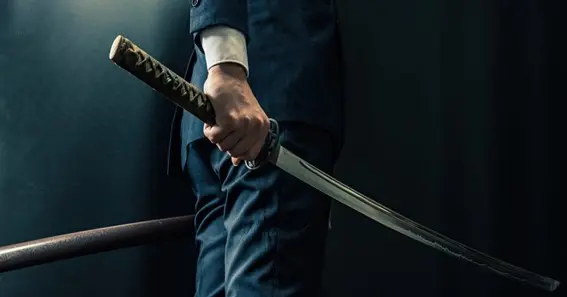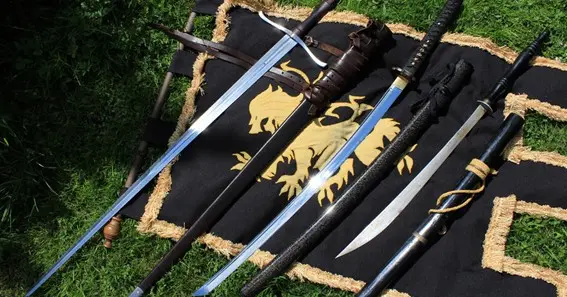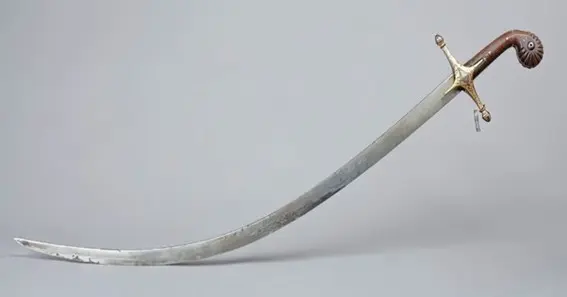What is a scimitar? A scimitar is a curved, single-edged sword known for its effectiveness in slashing and its historical significance across the Middle East, South Asia, and North Africa. North Africa, South Asia, and the Middle East use scimitars, single-edged swords with bent, convex blades. European “scimitar” refers to a group of bent swords, not a specific form. Due to their unusual design and historical significance, fighters have wielded these swords for centuries. They are deeply embedded in their countries’ cultural and historical stories. The artistic, political, and environmental circumstances that shaped each Scimitar give it its particular characteristics. In this article we discuss about what is a scimitar and more about it.
What Is A Scimitar?
A scimitar is a curved, single-edged sword known for its effectiveness in slashing and its historical significance across the Middle East, South Asia, and North Africa. Scimitars’ unusual design and single-edged, bent blades gave them an advantage in warfare. The blade’s curvature makes it practical for slashing and slicing, especially for mounted combatants. Central Asian ghilmans, or slave soldiers, transported their martial arts to the Islamic world, influencing the Scimitar. Over time, the Scimitar symbolized strength, status, and combat expertise.
Things You Ought To Understand About Hand Swords

It is a curved, one-edged sword that is good at close combat and has deep roots in the Middle East, South Asia, and North Africa. Since they come from various locations, scimitars have a lengthy history and appear in diverse shapes and sizes, each with qualities that characterize their cultures. After know about what is a scimitar, now understanding these sorts and their history is crucial to understanding the weapon’s impact.
Roots, Changes
The Scimitar originated in the Middle East to satisfy fighters’ needs. Ghilmans from Central Asia brought blade designs to the Middle East and joined Islamic armies. The sword designs influenced the Scimitar. To suit the area and Middle Eastern armies, slave troops brought their own weaponry and fighting styles. Moving quickly and slashing hard were crucial when battling horses. Here’s how the Scimitar formed. The Scimitar’s curved design made it simpler to handle on horses, which helped it become famous in Islam.
Cultural Significance
If you know what is a scimitar, you must know scimitars are significant in their civilizations. The Scimitar is more than a tool in Middle Eastern, South Asian, and North African cultures. It symbolizes power, authority, and bravery. Many works of art, literature, and religion demonstrate it. Carrying it symbolizes bravery, power, and martial arts. Some link the Scimitar to Islamic art and culture. Many art forms, from drawings to architecture, show it. Given its importance in defending the faith and growing Islamic empires, the Scimitar symbolizes divine justice and security in Islam.
Different Sword Types

After know about what is a scimitar, you should know a series of swords called “scimitar” have similar curved curves but varied regional variations that reflect their historical and cultural origins:
- Shamshir: Hamshirs are among the oldest and most famous scimitars from Persia and cut powerfully due to their highly curved blade. Persian fighters like the shamshir because it looks and operates well. This sword inspired several bent swords throughout the Islamic world.
- Saif: Arab swords, like the saif, have a weaker bend than the shamshir. During Islam, the saif was popular throughout the Arabian Peninsula and North Africa. Warriors and traders carried the saif, which could slash and push.
- Salawar: The Indian talwar sword has a broad blade and a distinctive guard that protects the hand during battle. South Asian fighters, including the Mughals, used it often. The blade is slightly curved and broader near the tip for easy cutting. Talwars are tools and symbols of South Asian martial arts.
- Ilyas: A Turkish sword with a sharp curve near the tip, the kilij is ideal for horseback combat. The kilij’s design enables powerful slashing attacks while efficiently controlling and balancing. It was a favorite of Ottoman riders. The Ottoman army employed the kilij for festivities and to show its strength.
- Nimcha: North African swords like the Simcha have a distinctive handle that blends curved and straight blades. The niche’s design symbolizes Moroccan and Algerian resistance to foreign invaders. It is versatile and suitable for numerous fighting styles.
- Pulwar: Pulwars are Afghan swords with broader blades and more curves. Their design combines Persian and Indian sword-making traditions. Afghan warriors donned pulsars in battle and rituals. They symbolized regional martial arts.
Planning, Building
Artisans consider scimitar shape and function. Steel blades are usually robust and flexible. The blade’s form optimizes cutting, allowing deep, powerful cuts to penetrate armor and deal significant damage. The Scimitar balances lightness and strength in warfare, making it valuable for offense and defense. Beautiful ivory, silver, and gold handles are common on scimitars, proving that the sword is both art and tool.
Conclusion
To conclude, the Scimitar is more than a sword. It represents Middle Eastern, South Asian, and North African martial arts and culture. Its unusual curving design, practical beauty, and historical significance have drawn people to this tool for centuries. The Scimitar represents a lengthy history of battle, culture, and craftsmanship, showcasing swordsmiths and fighters’ inventiveness and skill. In above we discuss about what is a scimitar and explore more about it.
FAQs
What’s The Sword-Scimitar Difference?
Scimitar blades are more prominent and sharper than katana blades, which are longer and have a slight bend. Each is culturally diverse.
What Did The Scimitar Do In Battle?
Scimitars were used for close combat. Because they allowed fast, forceful hits, they worked well on horses.
Does Anybody Use Scimitars Anymore?
Even if modern swords don’t employ scimitars for fighting, collectors and history buffs enjoy them for their uniqueness and cultural worth.
What Were Scimitars Usually Constructed Of?
Most scimitars had wood, silver, or gold hilts and high-quality steel blades to emphasize their importance.
Why Are Scimitars Valued In The Middle East?
In art and literature, scimitars symbolize nationalism, power, and warriors. They also represent the region’s martial arts history.










